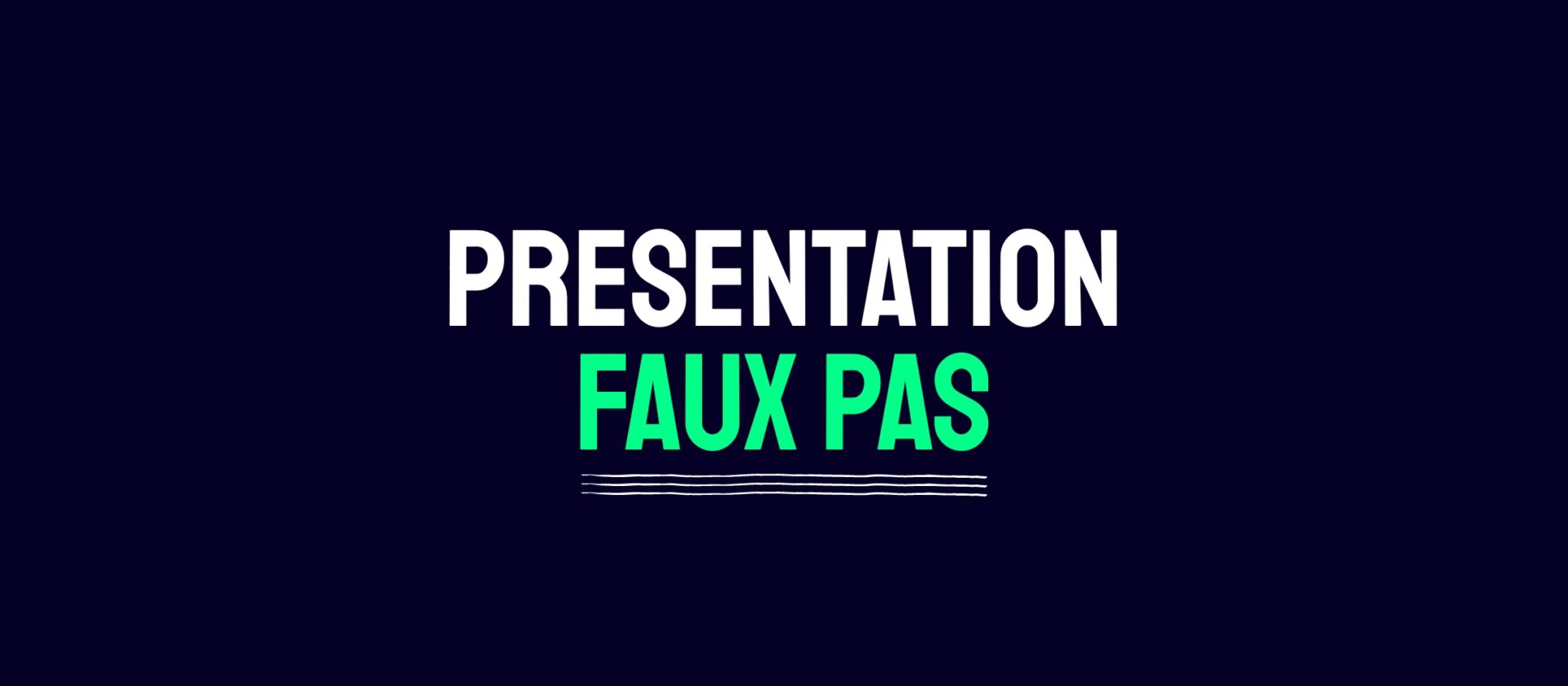Ever wondered if you’re making a huge mistake when presenting?
If you haven’t…well, you will now.
Don’t worry. We’ve got you covered. In this video, our Jaz and Matt are not only pointing out your presentation faux pas, but helping you to fix them as well.
Presentation faux pas video transcription
Too much text on the slides
Oh, where to even begin? There are so many. For a start, just having loads of text on a slide, nobody wants to sit and read that. You know, you’re presenting to a big room of people and you want them to just sit there and read? No.
So true, we see that all the time.
Yeah. Put it in the speaker notes! Focus on the main message. Put the rest in the speaker notes. You’re there to tell them. Just do it.
Imagery issues
We’ve got imagery. There are so many imagery faux pas. For a start, just really bad stock imagery that’s overly obvious. You know the kind I mean? Like a man climbing a ladder. The list goes on. And we’ve got stretched images, ones that have been really horribly compressed. They’re just all blurry.
Yeah, you can see every pixel.
Oh, yeah. And they’ve been compressed on top of compression so even the pixels get blurry and nobody can even see what it is.
Awkward animation
Animation can be really powerful. But when people try and do it without really knowing what they’re doing it can just look janky and weird. Especially if there are some effects that we would never touch.
Like pinwheel, things bouncing in…
The paper plane transition.
Oh, yeah, yeah. We love that.
Curtain does look pretty cool though.
I’ve never used it, but who’s to say?
Seriously dull decks
We see also a lot of super established brands come in through the door that you just would not expect to have these seriously dull decks. They have a beautiful website, beautiful branding, anything that they put out, adverts…
Everything has been so tailored to them and it looks amazing.
But then when they send through their pitch decks to us it’s like from a completely different place.
It’s shocking, isn’t it?
They’re doing these massive pitches worth millions of pounds sometimes and it’s just like, “What are you doing? Why are you showing people this?” It’s crazy. You just don’t expect that from these big brands.
And when they come to us because they’re losing business or whatever, it’s like, well…yeah.
Sometimes it feels like a lack of trust in their own brand as well. You can be a big company
and then you go and show a presentation. You’ve got your logo in the corner of every slide. It should be obvious who you are, why you’re there, what you’re doing.
The big companies tend to be quite reliant on charts. Just so many charts.
And the audience member is sitting there going “What am I supposed to look at here?”
Yeah, what’s the most important part of this data? Hmm.
Exactly. Yeah.
And if you’ve just got a slide with four charts and a table on it, what am I doing with that information?
Yeah, I don’t think they understand it from their audiences’ point of view.
Sometimes they only think about it from the person who is pitching and presenting. We can help in that aspect because we know both sides.
I think that’s key as well. Just really thinking about what your audience wants to see. What’s going to engage them? Ultimately, you’re there to change minds and you can’t do that with a bad presentation.
How to avoid presentation faux pas
So, what should these brands and companies be doing?
For a start they need to be paying as much attention to their presentations as they do to all their other collateral. Their business cards, website, videos. They need to put that same care and attention into their presentations and what does that mean?
You know what? What does a good presentation look like?
Break up your information. Just stick to the key phrases on each slide. The key message: what do you want this slide to say? And then you can tell the rest of that story.
You want great imagery.
You want to make sure things are consistent, not only between decks but within the same deck.
Sometimes we see clients putting different slides in from different presentations. It doesn’t look professional; it doesn’t look good.
What else have we got? Really smooth animation that really helps tell the story.
We do infographics all the time and how much better is it when you can tell the story through motion? Chop it up, let the story speak for itself in stages.
It doesn’t have to all come on at once.
Yeah and digest every single bit of it.
I mean this is a thing in TV and movies. Show. Don’t tell. You know, just show, what are we trying to communicate here? And your audience is immediately just going to understand what you’re talking about. So that’s a great thing to do. Definitely.
And like you say, mix up the visual storytelling. You can use images and videos, just make sure they’re tailored and in the same style throughout your presentation.
You touched on storytelling there as well and I think pitching correctly to the audience. They think they know how to speak to their audience, but pitching at the right level, in the right tone, is so important.
Yeah, I think you’re right.
I think storytelling and writing in general is so important. Really condensing down that message. What do they need to know?
And sometimes people fall into the trap of “Oh, I’ll have a general presentation that works for everything”, but it doesn’t work because it’s all just too general and you’re not focusing on what your audience needs.


